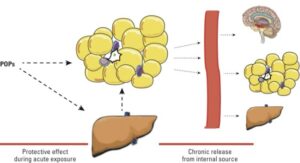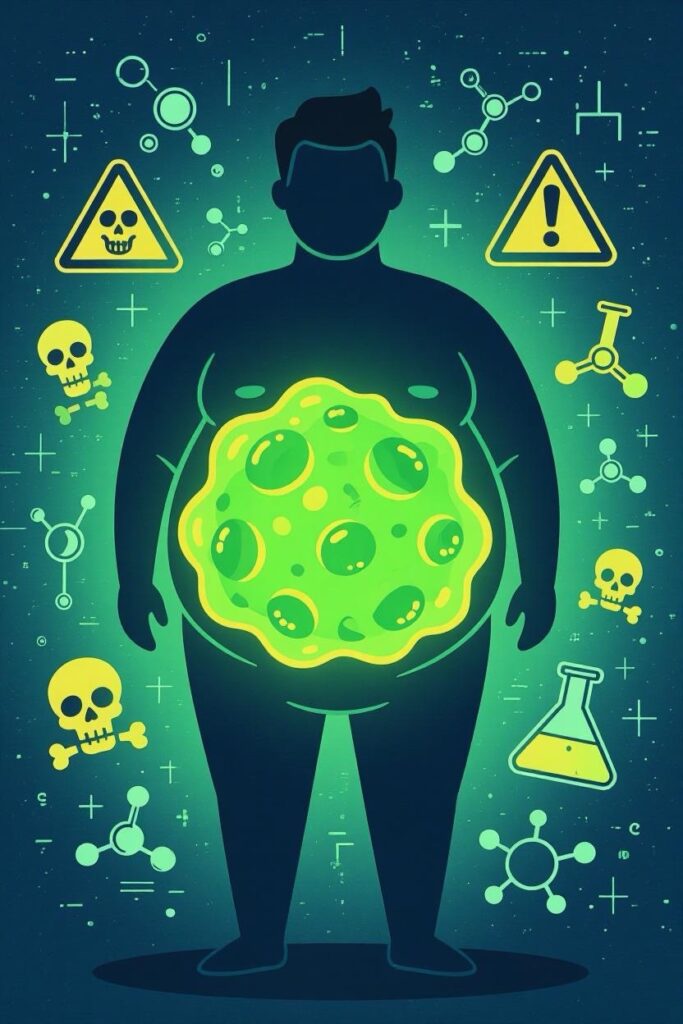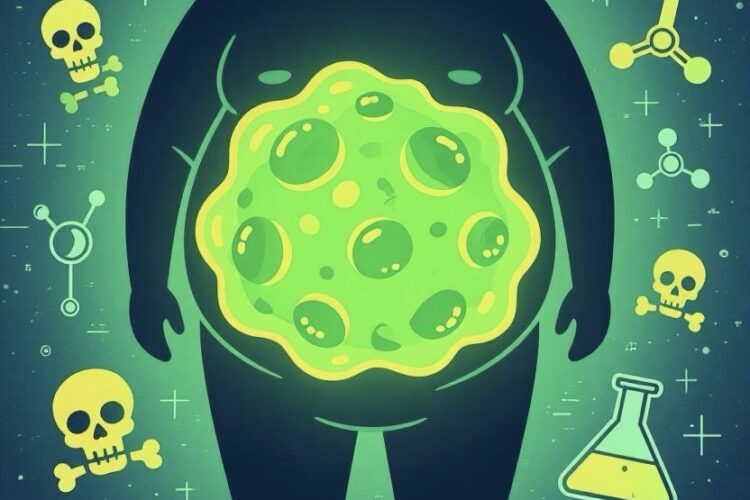Persistent organic pollutants (POPs) like PCBs, DDT, and PFAS accumulate in the fat of overweight and obese individuals, increasing risks of hormone disruption, immune issues, and chronic diseases such as diabetes, heart disease, and fatty liver disease. These lipophilic toxins, found in contaminated foods like farmed salmon and industrial byproducts, build up in adipose tissue, worsening metabolic syndrome and inflammation. Rapid weight loss can release POPs into the bloodstream, potentially causing further health issues. To reduce POP buildup, focus on clean eating with fresh, low-fat foods, gradual weight loss, and minimizing exposure to environmental toxins. Exercise and fiber-rich diets help limit absorption, while pre-pregnancy weight control lowers risks for infants. By managing weight and avoiding contaminated sources, individuals can reduce POP-related health risks and improve metabolic health.

Long Version
The Hidden Threat: Persistent Organic Pollutants in Body Fat and Their Impact on Health
Overweight and obese individuals often store higher levels of persistent organic pollutants (POPs) in their fat, amplifying health risks such as hormone disruption, immune dysfunction, and chronic diseases. These lipophilic compounds, environmental toxins that resist breakdown, bioaccumulate in adipose tissue, turning body fat into an adipose reservoir for toxicants. This accumulation exacerbates conditions like metabolic syndrome, insulin resistance, diabetes, cardiovascular disease, inflammation, and oxidative stress, while also linking to non-alcoholic fatty liver disease (NAFLD), dyslipidemia, type 2 diabetes, neurological disorders, respiratory diseases, and autoimmune disorders. Understanding this dynamic is crucial, as managing weight, eating clean, and reducing exposure can mitigate POP buildup and safeguard metabolic homeostasis.
Understanding Persistent Organic Pollutants (POPs)
Persistent organic pollutants encompass a range of synthetic chemicals, including polychlorinated biphenyls (PCBs), dichlorodiphenyltrichloroethane (DDT) and its metabolite dichlorodiphenyldichloroethylene (DDE), chlordane compounds (CHLs), hexachlorocyclohexanes (HCHs), hexachlorobenzene (HCB), polybrominated diphenyl ethers (PBDEs), hexabromocyclododecanes (HBCDs), perfluoroalkyl substances (PFAS), and dioxins. These endocrine-disrupting chemicals (EDCs) and obesogens are lipophilic, meaning they dissolve in fats and accumulate in lipid-rich tissues like visceral fat and subcutaneous fat. Sources of pollution exposure include dietary ingestion from contaminated foods—particularly farmed salmon contaminants, e-waste toxins, and heavy metals like lead and mercury—as well as industrial emissions, pesticides, and combustion byproducts. Once in the body, their toxicodynamics involve binding to nuclear receptors, altering gene expression, and promoting adipose tissue dysfunction.
Bioaccumulation occurs as these compounds magnify through the food chain, leading to higher concentrations in humans, especially in those with greater adiposity. In overweight individuals, increased body fat provides more storage sites, creating a vicious cycle where POPs act as obesogens, further driving fat storage and obesity. This process is influenced by factors like age, sex, and exposure timing, with mixtures of POPs showing synergistic effects on lipid accumulation.
The Link Between Obesity and POP Accumulation
In obese and overweight populations, adipose tissue serves as a primary depot for POPs, with levels correlating directly to adiposity and fat storage. Higher BMI and waist circumference are associated with elevated serum concentrations of these environmental chemical disruptors, as their lipophilic properties favor sequestration in fat. Obesogens like PFAS and PCBs disrupt adipogenesis by activating peroxisome proliferator-activated receptor gamma (PPARγ), leading to increased preadipocyte differentiation, lipid droplet enlargement, and impaired lipolysis. This results in adipose tissue dysfunction, including reduced insulin signaling, altered adipokine secretion (e.g., increased leptin, decreased adiponectin), and inhibition of brown fat thermogenesis.
Epidemiological data reveal that prenatal exposure to POPs programs obesogenic memory, heightening susceptibility to childhood obesity and metabolic disturbances later in life. For instance, maternal serum PFOS and PFOA levels during pregnancy associate with higher child BMI and overweight risk at age 5, with non-monotonic dose responses observed. Pre-pregnancy maternal overweight exacerbates this, as POPs transfer via persistent organic pollutant levels in human milk, affecting infant growth and adiposity.
Health Risks Associated with POPs in Fat
The storage of POPs in fat amplifies health risks through endocrine disruptors that mimic or block hormones, leading to hormone disruption and immune dysfunction. These include proinflammatory effects, where POPs upregulate cytokines like TNFα via NF-κB pathways, fostering chronic inflammation and oxidative stress in adipose tissue. Such changes contribute to metabolic syndrome, insulin resistance, and type 2 diabetes by impairing glucose uptake and promoting dyslipidemia.
Cardiovascular disease risks rise due to atherogenic dyslipidemia and hypertension, while NAFLD develops from hepatic steatosis induced by POPs like PCBs and DDT. Neurological disorders, respiratory diseases, and autoimmune disorders are also linked, with POPs altering brain development and immune responses. In vulnerable groups, prenatal exposure correlates with rapid weight gain, increased adiposity markers, and long-term chronic diseases. Sex-specific effects are notable, with stronger associations in females for certain POPs like dioxins.
The Challenges of Weight Loss and POP Release
While weight loss is key to reducing adiposity, it poses a double-edged sword: rapid weight loss or bariatric surgery triggers bloodstream release of stored POPs, potentially impairing metabolic homeostasis and stimulating the yo-yo effect. Studies show serum POP levels rise 1–3.5% per kilogram lost, with sustained increases post-surgery leading to cardiometabolic disturbances and weight regain. This mobilization from the adipose reservoir can exacerbate inflammation and insulin resistance, underscoring the need for gradual weight management strategies.
Strategies for Mitigation and Exposure Reduction
Reducing POP buildup requires multifaceted approaches. Exposure reduction starts with minimizing intake from sources like contaminated fish, meat, dairy, and e-waste toxins—over 90% of exposure comes from food. Clean eating emphasizes fresh, minimally processed foods low in fats, such as boiling or grilling to lower contaminants, while avoiding high-PAH methods like smoking. Dietary patterns rich in fiber can reduce PCB absorption, and limiting farmed salmon contaminants helps.
Weight management through gradual loss and physical activity counters adverse effects, as exercise may enhance POP elimination without massive release. For at-risk groups, pre-pregnancy weight control and monitoring persistent organic pollutant levels in human milk are vital to prevent prenatal exposure and childhood obesity. Global regulations like the Stockholm Convention aid by phasing out POPs, but personal vigilance remains essential for long-term health protection.
By addressing these elements, individuals can break the cycle of POP accumulation, fostering better metabolic health and reducing chronic disease burdens.

Hashtags For Social Media
#cleaneating #eatclean #detox #healthylifestyle #healthyfood #weightloss #fitness #nutrition #wellness #cleanse #organic #vegan #health #obesity #pollution #environment #savetheplanet #zerowaste #plasticpollution #climatechange #nature #mentalhealth #mindfulness #fitfam #workout #gym #diabetes #fatloss #keto #lowcarb
Related Questions, Words, Phrases
what are persistent organic pollutants? | how do pops build up in body fat? | health risks of pops in overweight people | what causes pops accumulation in adipose tissue? | how to reduce pops exposure in daily life? | effects of pcbs on hormone disruption | pops and obesity link explained | dangers of ddt in human fat stores | ways to lower pops levels through diet | persistent organic pollutants and chronic diseases | how rapid weight loss releases pops | pops in farmed salmon and health impacts | environmental toxins in visceral fat | immune problems from pops bioaccumulation | strategies for clean eating to avoid pops | pops and metabolic syndrome connection | reducing pops buildup with exercise | prenatal exposure to pops risks | how pfass affect fatty liver disease | inflammation caused by lipophilic compounds | pops in subcutaneous fat health effects | yo-yo dieting and pops release | heavy metals like lead in body fat | e-waste toxins and obesity | dioxins hormone disruption in adults | childhood obesity from maternal pops | fiber-rich diets to limit pcb absorption | autoimmune disorders linked to pops | neurological issues from persistent pollutants | cardiovascular risks of pops in fat | insulin resistance due to endocrine disruptors | obesogens and weight gain cycle | pre-pregnancy weight control for pops reduction | global regulations on pops like stockholm convention






